Residential buildings, churches, swimming pools, power stations and bunkers: the models weighing up to five tonnes on a scale of 1:25 are made of concrete, acrylic glass, wood and stainless steel. Travelling from Julius von Bismarck’s studio, they were loaded on to the transport vessel at the Borsighafen port in Berlin using a lattice boom crane on the day prior to their departure. The push boat with its pontoon started its journey from Berlin to the Port of Duisburg via the Mittelland Canal, the Dortmund-Ems Canal and the Rhein-Herne Canal on Saturday.
The journey to the future exhibition site forms part of the artistic concept and the choice of an inland waterway vessel as the means of transport is a sign of coming to terms with ecological issues. At the same time, the objects stemming from buildings, which have long since been demolished, ideally fit in with the pontoon, which has a particularly old-fashioned appearance. The slow, sustainable trip is therefore an art performance too.
"We’ve deliberately selected an old pontoon for the journey to meet the artists‘ request with regard to transportation. The sculptures can be openly exhibited in an exposed manner there, they almost float across the water’s surface and aren’t enclosed in some dark cargo hold," says David Schütz, the Project Manager at Deutsche Binnenreederei.
"Working together with Marta Dyachenko, I’ve designed an urban ensemble from buildings, which were formerly located in the Ruhr region, within a period of two years. They’re visions, which in this case have not been fulfilled, and have become concrete. We’re reconstructing them as a town of the future, which has not arrived yet, and are therefore inviting people to reflect on things," the Berlin artist, Julius von Bismarck, explains.
"As a long-standing company in Duisburg, we’ve already been promoting the idea of activating the Rhine/Ruhr region at many levels for a long time. The "New Town" project has created some value added and it reminds us both of the history of inland waterway shipping and also the unique character of our metropolitan area. This provides some particularly positive stimulus, particularly in these challenging times. The port team warmly welcomes the project," duisport spokesperson, Thomas Hüser, explains.
The probable arrival date is 3 April. The building sculptures will then be transported to their destination at the Landschaftspark-Nord park in Duisburg and installed. The new site-specific artworks for the Emscher Art Trail – which is a cooperation between the Urbane Künste Ruhr cultural institution, Emschergenossenschaft (the Emscher Water Board) and the Ruhr Regional Association – will probably be opened to the public during April. 18 permanent works of art can currently be viewed in the public area along the Sculptures‘ Trail next to the river Emscher.
About duisport
MORE THAN A PORT. Duisburger Hafen AG is the holding and management company for the Port of Duisburg, the largest inland waterway port in the world. The duisport Group provides full-service packages in the fields of infrastructure and superstructure, including settlement management, for the port and logistics site. The subsidiaries also provide logistical services such as establishing and optimising transport and logistical supply chains, railway transport services, building management, third-party and packaging logistics.
The Rhenus Group is a leading logistics service provider with global business operations and annual turnover of EUR 5.5 billion. Rhenus has business sites at 750 locations worldwide and employs 33,000 people. The Rhenus Group provides solutions for a wide variety of different sectors along the complete supply chain; they include multimodal transport operations, warehousing, customs clearance as well as innovative value-added services.
Rhenus SE & Co. KG
Rhenus-Platz 1
59439 Holzwickede
Telefon: +49 (2301) 29-0
Telefax: +49 (2301) 29-1215
http://www.rhenus.de
Unternehmenskommunikation
Telefon: +49 (2301) 29-1862
Fax: +49 (2301) 29-1215
E-Mail: verena.schaefers@de.rhenus.com
![]()

